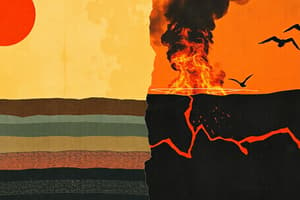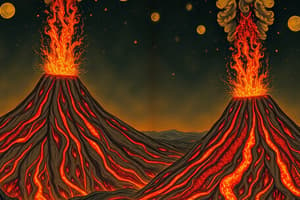Podcast
Questions and Answers
Which of the following is a key difference between magma and lava?
Which of the following is a key difference between magma and lava?
- Magma is only found in shield volcanoes, while lava is present in all types of volcanoes.
- Magma is a result of phreatomagmatic eruptions, while lava is a result of phreatic eruptions.
- Lava contains more gases than magma.
- Magma is molten rock beneath the Earth's surface, while lava is molten rock ejected onto the surface. (correct)
A volcano has steep slopes and a wide crater composed of ejected lava fragments. What type of volcano is it MOST likely to be?
A volcano has steep slopes and a wide crater composed of ejected lava fragments. What type of volcano is it MOST likely to be?
- Composite Volcano
- Cinder Cone Volcano (correct)
- Shield Volcano
- Inactive Volcano
Which type of volcanic eruption is MOST likely to occur when magma interacts with water?
Which type of volcanic eruption is MOST likely to occur when magma interacts with water?
- Vulcanian
- Strombolian
- Phreatomagmatic (correct)
- Phreatic
Mount Kanlaon shows no volcanic activity and has no record of past eruptions. Based on this information, how would you classify Mount Kanlaon?
Mount Kanlaon shows no volcanic activity and has no record of past eruptions. Based on this information, how would you classify Mount Kanlaon?
Which volcanic feature describes a funnel-shaped depression typically found at the summit of a volcano, formed by explosive eruptions?
Which volcanic feature describes a funnel-shaped depression typically found at the summit of a volcano, formed by explosive eruptions?
Which of the following eruption types is characterized by excessively explosive events involving gas and pyroclastics, potentially reaching extreme levels of violence?
Which of the following eruption types is characterized by excessively explosive events involving gas and pyroclastics, potentially reaching extreme levels of violence?
If a volcanologist observes periodic weak to violent eruptions characterized by fountain lava, which type of eruption is he MOST likely witnessing?
If a volcanologist observes periodic weak to violent eruptions characterized by fountain lava, which type of eruption is he MOST likely witnessing?
What type of volcano could be expected to have alternating layers of lava and pyroclastic deposits?
What type of volcano could be expected to have alternating layers of lava and pyroclastic deposits?
Flashcards
Volcano
Volcano
An opening in Earth's surface where molten rock, gases, and ash are ejected.
Base of a Volcano
Base of a Volcano
The bottom part of a volcano that supports its structure.
Crater
Crater
A funnel-shaped depression at the volcano's summit formed by explosions.
Shield Volcano
Shield Volcano
Signup and view all the flashcards
Cinder Cone Volcano
Cinder Cone Volcano
Signup and view all the flashcards
Plinian Eruption
Plinian Eruption
Signup and view all the flashcards
Active Volcano
Active Volcano
Signup and view all the flashcards
Caldera
Caldera
Signup and view all the flashcards
Study Notes
Volcanoes
- Volcanoes are openings in the Earth's surface where molten rock, smoke, gases, and ash are ejected.
- Mayon Volcano in the Philippines is a popular example of an active volcano with a perfect cone shape.
Volcano Parts
- Base: The bottom of the volcano.
- Slope: The sides of the volcano.
- Summit: The top of the volcano where the crater is located.
- Crater: A funnel-shaped depression at the top of a volcano formed by explosive eruptions.
- Caldera: A large crater formed when a part of the volcano's wall collapses following an explosive eruption.
Magma and Lava
- Magma: Hot, fluid, or semi-fluid material beneath or within the Earth's crust.
- Lava: Molten rock that is ejected from a volcano.
Types of Volcanoes by Shape
- Shield Volcano: Formed by the accumulation of fluid lava flows; broad, slightly domed structure resembling a warrior's shield (e.g., Mauna Loa in Hawaii).
- Cinder Cone Volcano: Built from ejected lava fragments; steep slopes, wide craters, and the most abundant volcano type (e.g., Mount Paricutin in Mexico).
- Composite Volcano (Stratovolcano): Large, nearly perfect cone-shaped structures formed by alternating layers of lava and pyroclastic deposits (e.g., Mayon Volcano in the Philippines).
Types of Volcanoes by Eruption
- Phreatic: Stream-driven eruption caused by hot rocks coming into contact with water; also known as a hydrothermal eruption (e.g., Taal Volcano eruption in 2020).
- Phreatomagmatic: Violent eruption caused by the interaction of water and magma, resulting in a fine ash eruption.
- Strombolian: Periodic weak to violent eruption characterized by fountain lava.
- Vulcanian: Tall eruptions that reach up to 20 kilometers high with pyroclastic flows and ash.
- Plinian: Excessively explosive eruption of gas and pyroclastics, with intense violence (e.g., Mount Pinatubo eruption in 1991).
Volcano Activity
- Active Volcano: A volcano that has a history of eruptions.
- Inactive Volcano: A volcano that shows no activity and has no record of eruptions (e.g., Mount Kanlaon in the Philippines).
Volcano Importance
- Volcanoes are a key factor in sustaining life on Earth.
- Volcanic activity helps keep the Earth warm and wet, which are crucial for life.
Studying That Suits You
Use AI to generate personalized quizzes and flashcards to suit your learning preferences.




